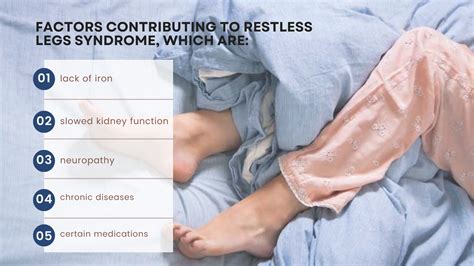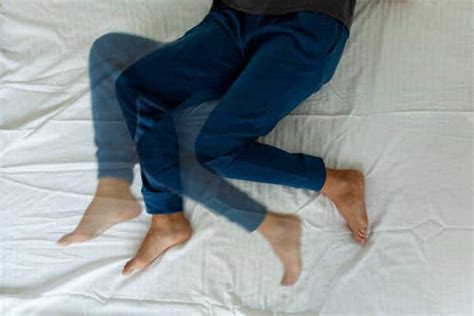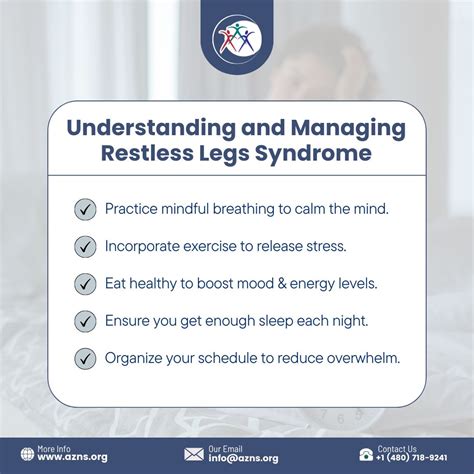Intro
Relieve restless legs syndrome at night with natural remedies, treatment options, and lifestyle changes, alleviating symptoms of RLS, nocturnal leg cramps, and insomnia for a restful sleep.
Restless Legs Syndrome (RLS) is a common condition that affects millions of people worldwide, causing uncomfortable sensations in the legs, particularly at night. These sensations can range from mild to severe and are often described as itching, burning, or tingling. For many individuals, RLS can significantly disrupt their sleep patterns, leading to fatigue, decreased productivity, and a reduced quality of life. Understanding the causes, symptoms, and treatment options for RLS is essential for managing the condition and improving overall well-being.
The importance of addressing RLS cannot be overstated, as it not only affects the individual but also their loved ones. Sleep disturbances caused by RLS can lead to mood swings, irritability, and decreased cognitive function, making everyday tasks more challenging. Furthermore, RLS can be a symptom of underlying health issues, such as iron deficiency, diabetes, or kidney problems, highlighting the need for a comprehensive approach to diagnosis and treatment. By exploring the complexities of RLS and its impact on daily life, individuals can better navigate the condition and seek effective solutions.
Restless Legs Syndrome is often misunderstood or misdiagnosed, which can delay appropriate treatment and exacerbate symptoms. Raising awareness about RLS is crucial, as it can help individuals recognize the signs and symptoms, prompting them to seek medical attention. A thorough understanding of RLS can also facilitate more effective communication between patients and healthcare providers, leading to more accurate diagnoses and personalized treatment plans. As research continues to uncover the underlying mechanisms of RLS, new therapies and management strategies are being developed, offering hope for those affected by this condition.
Understanding Restless Legs Syndrome

Symptoms of Restless Legs Syndrome
The symptoms of RLS can vary in severity and frequency, but common characteristics include: * Uncomfortable sensations in the legs, such as itching, burning, or tingling * An irresistible urge to move the legs, often accompanied by restlessness or fidgeting * Symptoms worsen during periods of rest or inactivity * Relief from symptoms upon movement or activity * Symptoms often occur in the evening or at night, disrupting sleep patternsCauses and Risk Factors of Restless Legs Syndrome

Diagnosing Restless Legs Syndrome
Diagnosing RLS can be challenging, as the symptoms can be similar to those of other conditions. A comprehensive medical history, physical examination, and laboratory tests can help healthcare providers make an accurate diagnosis. The following criteria are often used to diagnose RLS: * An irresistible urge to move the legs, usually accompanied by uncomfortable sensations * Symptoms occur primarily at night or during periods of rest * Symptoms are relieved by movement or activity * Symptoms are not solely explained by another medical conditionTreatment and Management of Restless Legs Syndrome

Home Remedies for Restless Legs Syndrome
In addition to medical treatment, several home remedies can help alleviate RLS symptoms: * Warm baths or showers: Soaking in warm water can help relax the muscles and reduce discomfort * Massage: Gentle massage or self-massage techniques can help reduce tension and promote relaxation * Stretching exercises: Regular stretching can help improve flexibility and reduce muscle cramps * Avoiding triggers: Identifying and avoiding triggers, such as caffeine and nicotine, can help reduce symptomsCoping with Restless Legs Syndrome

Future Directions in Restless Legs Syndrome Research
Research into RLS is ongoing, and new discoveries are continually being made. Some areas of focus include: * Genetics: Further understanding the genetic factors that contribute to RLS can help identify new treatment targets * Neuroimaging: Using advanced neuroimaging techniques to study the brain and nervous system can provide valuable insights into the underlying mechanisms of RLS * Alternative therapies: Investigating the effectiveness of alternative therapies, such as acupuncture and massage, can provide new treatment options for individuals with RLSWhat are the most common symptoms of Restless Legs Syndrome?
+The most common symptoms of RLS include uncomfortable sensations in the legs, such as itching, burning, or tingling, and an irresistible urge to move the legs.
How is Restless Legs Syndrome diagnosed?
+RLS is diagnosed through a comprehensive medical history, physical examination, and laboratory tests to rule out other conditions that may be causing the symptoms.
What are some effective treatment options for Restless Legs Syndrome?
+Effective treatment options for RLS include lifestyle changes, iron supplements, dopaminergic agents, opioids, and alternative therapies such as acupuncture and massage.
In conclusion, Restless Legs Syndrome is a complex condition that can significantly impact an individual's quality of life. By understanding the causes, symptoms, and treatment options for RLS, individuals can better navigate the condition and seek effective solutions. We invite you to share your experiences and thoughts on RLS in the comments below, and to explore our resources for further information on managing this condition. Together, we can work towards improving the lives of those affected by RLS and promoting a deeper understanding of this often-misunderstood condition.
